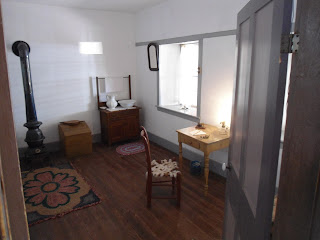 |
| Liz at the trail head |
I mapped out our route, determining that we would take the Chuckwalla Trail to the Turtle Wall Trail, to the Paradise Rim Trail, to the Halfway Wash Trail and back to the Chuckwalla Trail. Because of the numerous trails in the area, staying on the right one proved to be difficult, eventhough most of the trails are well signed.
The Chuckwalla Trailhead is found on Hwy 18 (Bluff Street) just 4 miles north of I-15. There is a large sign on the right side of the road, indicating that the turnoff to the Chuckwalla Trailhead is across the street on the left hand side of the road.
 |
| The parking area |
I printed out a map before we left so I knew the location of all the trails. We started through the hikers gate by where we parked our car, and joined up with the Chuckwalla Trail, which actually started directly at the other hikers gate, .1 of a mile away.
Just .1 of a mile in, we saw a couple groups of rock climbers scaling a 50 foot rock off to the side of the trail. We stopped for a few seconds to watch, before continuing on our way. After .8 miles on the Chuckwalla Trail, we came to a trail sign indicating that the "North Crossing" trail descended off to the left, and that the "Beck Hill" trail continued straight. Since the North Crossing trail wasn't even on my map, we decided to continue sraight on to the Beck Hill Trail (the Chuckwalla Trail turns into the Beck Hill trail here). This is where we deviated from our actual plan, and was the source of a little confusion later.
We continued on the Beck Hill Trail for 1.5 miles, taking in the pretty views of volcanic rock off to the north, until it came to a sign indicating that the Gila Trail went off to the right. At this point, the trail that we had just been on, the Beck Hill Trail, seemingly ended into this new trail. But while there was a sign indicating that the Gila Trail was off to the right, there was no sign indicating what trail went off to the left.
 |
| Looking down at Santa Clara |
.2 miles after starting off on this new trail, we saw a sign that added to our confusion - The Turtle Wall Trail went off to the right. I thought we had been on the Turtle Wall Tail when we were on the Beck Hill Trail.
We decided to continue straight on the trail we were on which we still hadn't found an official name for, although we correctly supposed it to be the Paradise Rim Trail. After 3 miles, we finally confirmed that we were on the Paradise Rim Trail as we came to the signed junction with the gecko trail.
We veered to the left to stay on the Paradise Rim Trail, and after .3 more miles, came to another signed junction with The Gap trail. (The Gecko and Gap trails create a short .6 mile loop that can be added on to this hike).
 |
| A trail junction |
From here, we went back out theway we came in, again passing the rock climbers. We made it back to our car at about 1:00, just under 2 hours from when we left, and after 4.84 miles of hiking.
Now that I've hikedin the area, it would be easy to know where all the trails are, but because of my newness to this area, this hike proved to be an adventure. Although it would be very hard to get lost if you have any sense of direction, before attempting this hike, I would suggest getting a map of the area (Red Cliffs Reserve Map). There is no water on this hike, and I imagine it would be very hot in the summer. It is a relatively easy hike, although there are parts of the hike where the trail is made up of deep sand which makes the going a little tougher.
 |
| The Beck Hill Trail as it winds past the volcanic rock. |



















